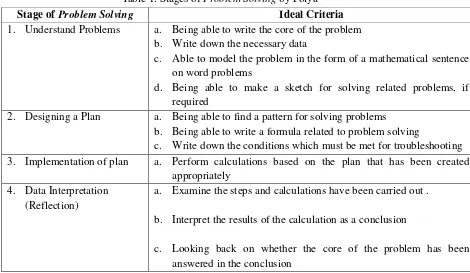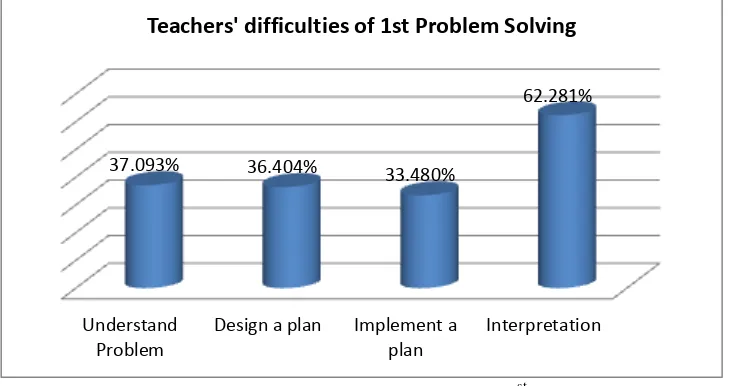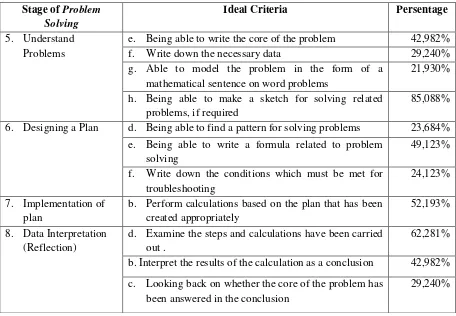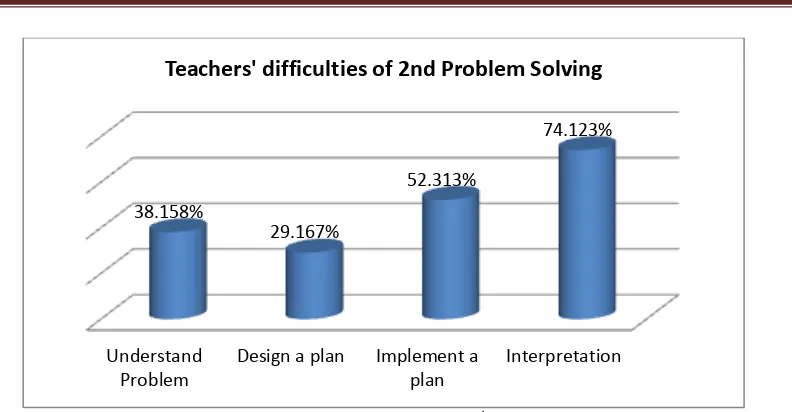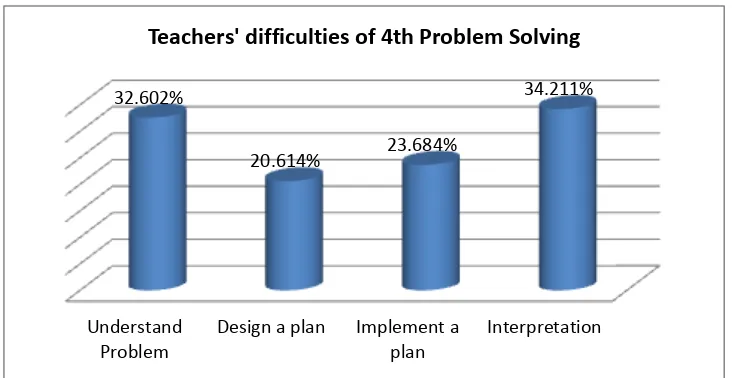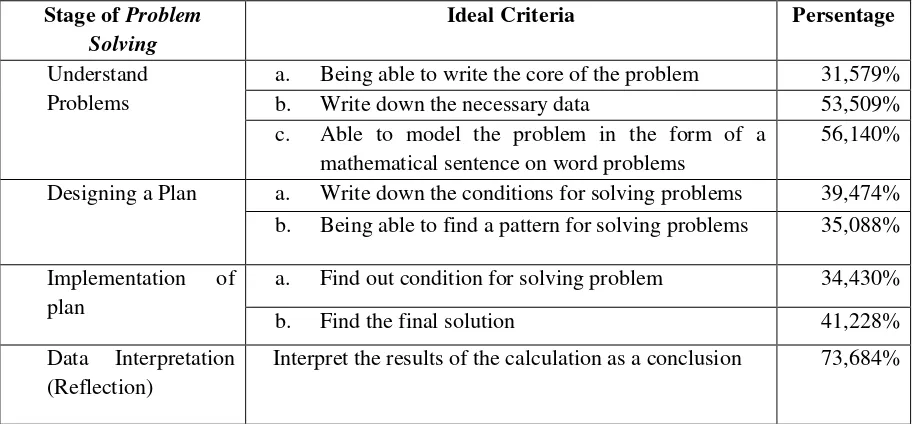THE IDENTIFICATION OF DIFFICULTIES IN PROBLEMS SOLVING OF
MATHEMATICS TEACHERS IN JUNIOR HIGH SCHOOL OF NUSA
TENGGARA TIMUR AND MALUKU UTARA
Heri Retnawati, Dhoriva Urwatul Wutsqo, Endang Listyani, Kartiko Rachman Y.P.
Mathematics Department, Mathematics and Science Faculty, State University of Yogyakarta
Abstract
This study aims are determining the difficulties of mathematics teachers in the junior high school to solve mathematics problems in Nusa Tenggara Timur and Maluku Utara, the two of 33 province in Indonesia . This is a descriptive explorative research, using the documentation data that is answers of 114 mathematics teachers in class IX of Junior High School to the 5 items of national examination test. The 5 items are the most difficult item according to the students , particularly in the school that the school graduation has not reached 100 % in the Nusa Tenggara Timur and Maluku Utara . The results showed that the order of difficulties of mathematics teachers for solve the mathematics problems in the region are the execution plan problem solving, understanding the problems , interpreting the results , and planning a problem solving . This is indicated by the percentage of the difficulty teachers at each stage , 45.846 % of teachers had difficulty in understanding the problem , 33.063 % in the problem solving plan, 46.491 % in the completion of the plan execution problem, and interpret the results of 43.129 % on completion the problem.
INTRODUCTION
Various factors affect the successfullnes of education (Bridge , Judge & Mock , 1979), i.e. teachers, students, leaders and leaderships, etc. From these various factors, teachers contribute 15 % (Sallis , 2002). To be a teacher who played a major role in determining the successfullness of the students, teachers should ideally have a personal competence, social competence, academic and professional competence. One related matter to support the successfullness of professional competence is mastering the subject master is a major component in the professional competence. This competency can be determined by evaluating the teacher, by conducting tests and analyzing it.
ME-264
(region 3), and NTT, North Maluku, and Papua (region 4).
However, analytical test results that are solving the problem has not been fully utilized and explored. One of the things that can be done is utilize this data, to identify the difficulties mathematics teachers in solving problems. The mathematical problem solving include understanding the concepts, language interpretation, algorithms, and computation. Mistakes made by the teachers, which led to the ability to solve the problem could not be explored using teacher answers to essay test. The results can be presented as a profile of mistakes done by teachers. With the profile of mistakes made by teachers in problem solving, improvement efforts can be made from policy, training, community service, and other actions that can improve mastery of teachers on the subject matter and improve problem-solving abilities in order to improve the professional quality of academic teachers. Based on this background , in this study will be expressed difficulty in solving the problem of teachers according to Polya which is a reflection of the ability of junior high school teacher with a mastery of the material related to implementing the learning of mathematics.
Evaluation in education carried out to obtain information on aspects related to education. According to Gronlund (1990), evaluation in education has a purpose: a) to provide clarification of learning outcomes that have been implemented, b) provide information on the achievement of short-term goals that have been implemented, c) provide input to the advancement of learning, d) provide information about the difficulties in learning and to choose the learning experience in the future. Evaluation information can be used to help decide a) the suitability and sustainability of learning objectives, b) the usability of learning materials , and c) to determine the level of efficiency and effectiveness of teaching strategies (methods and learning techniques) are used.
One of the interesting things to talk about, regarding the evaluation and the results are related to mathematics. Many experts opinions expressed on the mathematical definition of the term. According to Gold (2008), mathematics has many interpretations. Mathematics may be defined by its contents (Gold , 2008), which studied objects in mathematics (Avigad , 2008), can also be defined as a process of thinking (Lewis, without year). In particular , Reys , et al . (1998) defines mathematics as a lesson on patterns and relationships, ways of thinking, art is characterized by rules and consistency, language use terms and certain symbols, as well as a useful tool in everyday life as well as help the development of other sciences.
Math can also be viewed as a structure of relationships linking symbols . This view is based on the idea of how the formation of mathematics. In this regard, Ruseffendi argued that mathematical ideas are formed as a result of human-related ideas, processes and reasoning (Ismail,1998). .
general conclusion that can be proven (James & James, 1976). Definitions , axioms and theorems is a unity constituting a mathematical concept.
The mathematical objects are abstract, which are correlated to form a new concepts, more complex concepts (Skemp, 1971: 37), and arranged in a hierarchy , a concept which became the basis for further study concept (Herman Hudoyo, 1988: 3). Finally found a mathematical concept is applied back to nature, and humans use it to meet their needs.
Mathematical knowledge is basically used in human life. Utilization is used to solve the problem (Polya,1973). The steps to solve the problem by Polya categorized into 4 stages of understanding the problem , designing the plan for solution, implement the plan, and interpretation/reflection. These steps can also be presented in Table 1.
Table 1. Stages of Problem Solving by Polya
Stage of Problem Solving Ideal Criteria
1. Understand Problems a. Being able to write the core of the problem b. Write down the necessary data
c. Able to model the problem in the form of a mathematical sentence on word problems
d. Being able to make a sketch for solving related problems, if required
2. Designing a Plan a. Being able to find a pattern for solving problems b. Being able to write a formula related to problem solving
c. Write down the conditions which must be met for troubleshooting 3. Implementation of plan a. Perform calculations based on the plan that has been created
appropriately 4. Data Interpretation
(Reflection)
a. Examine the steps and calculations have been carried out .
b. Interpret the results of the calculation as a conclusion
c. Looking back on whether the core of the problem has been answered in the conclusion
ME-266
information and communication technology to develop themselves.
Polya (1984 : 525-526) sparked 10 commandments for teachers ten things that need to be considered by teachers to improve their professional competence . The ten principles are: 1. Be interested in your subject line
2 . Know your subject
3 . Try to read the faces of your students ; try to see their expectations and Difficulties ; put yourself in their place.
4 . Realize that the best way to learn anything is to discover it by yourself.
5 . Give your students not only information, but know-how, mental attitudes, the habits of methodical work.
6 . Let them learn guessing. 7 . Let them learn proving.
8 . Look out for such features of the problem at hand as may be useful in solving the problems to come - try to disclose the general pattern that lies behind the present concrete situation. 9 . Do not give away your whole secret at once - let the students guess before you tell it- let them find out by Themselves as much as is feasible.
10 . Suggest it ; do not force it down their throats.
METHOD
This study is an exploratory descriptive study with a quantitative approach . Difficulty in solving mathematics teachers to solve mathematics problems identified by the steps of problem solving Polya then described. The object of this study is responses of mathematics teachers to the test of the National Exam. The mathematics teachers who participated the 111 mathematics teacher in junior high school in the Nusa Tenggara Timur (NTT) and 3 teachers from Maluku that achievement of his/her school has low average scor in the National Exam (which graduation is less than 80 % in 2010 and 2011), which has been modified from multiple choice test to essay test. Then from this problems were be developed the rubrics for scoring associated with Polya problem solving models, includes understanding the problems, planning problems, execute plans, and interpretation.
Data collected by the method of documentation of research activities of Puspendik Balitbang Kemendikbud 2011 in the form of a mathematics test results (essay test for the final grade teachers in junior high school). The data have not been analyzed in detail, especially related to the stages of how to use mathematics as a tool to resolve the problems. The essay test is used to determine teachers' mastery of the competency standard, prepared by material considered difficult by students based the absorption during the last five-six years (2006-2011). The results of the national exams of each school was obtained from the Puspendik Kemendikbud.
. Furthermore, based on the results of this analysis, the recommended suggestions for improvement in order to improve the quality of education in general, particularly enhancing the ability of solving mathematical problems related to teacher professional abilities.
Table 2. National Competency Standards that were Difficult to Achieve and as basic for developing problem solving of essay test for mathematics teachers
No. of Problems
Competencies Standard Used for developing problem solving of essay test for mathematics teachers
1 Determine the surface area of the curved side 2 Specify the gradient , equation , and graph
3 Complete the questions with the concept of congruency 4 Determine the volume of curved side
5 Determine measures of central tendency and use of data in solving everyday problems
RESULTS
1. Determine the surface area of a cone
Of the total of 114 mathematics teachers in Region 4 is working on the number one, as much as 37.093 % of teachers have not been able to understand the problem well. Understand the problem in the form of the first question is divided into four substage: write the core problem, which is known to write the data, modeling the problem and selecting variables with appropriate notation, and sketching. In the first case, the level of difficulty of teachers as measured from the errors presented in Figure1.
Figure 1. Difficulties in Problem Solving of 1st Problem
Mathematics teachers in NTT and Maluku can understand the core of mathematical problems presented in issue number 1 with an indication of 42.982 % of teachers who made a
Understand Problem
Design a plan Implement a plan
Interpretation 37.093% 36.404% 33.480%
ME-268
mistake in the description of the stage to understand the problem: write the core of the problem. Accordingly, a total of 29.240 % of teachers in Indonesia did not write the data provided in Question 1. At the sketching stage, 85.088 % of mathematics teachers who have not been able to use the sketch as a tool for problem solving. At the stage of completion of the plan first about the problem, there are 23.684 % of teachers made a mistake in the description of problem solving stage plan to form a hard time finding or using wide blanket cone formula. Details of the percentage of errors that indicate the difficulty of teachers at each substage of Polya problem solving items was the number 1 are presented in Table 3.
Table 3. Summary of Difficulty in 1st Problem Solving
Stage of Problem Solving
Ideal Criteria Persentage
5. Understand Problems
e. Being able to write the core of the problem 42,982%
f. Write down the necessary data 29,240%
g. Able to model the problem in the form of a
6. Designing a Plan d. Being able to find a pattern for solving problems 23,684% e. Being able to write a formula related to problem
b. Perform calculations based on the plan that has been created appropriately
52,193%
8. Data Interpretation (Reflection)
d. Examine the steps and calculations have been carried out .
62,281%
b. Interpret the results of the calculation as a conclusion 42,982% c. Looking back on whether the core of the problem has
been answered in the conclusion
29,240%
2. Determine the slope, equation, and graph
The second problem relates about functions straight line perpendicular to the other line and through a point, but there are additional problems which depicts two lines in a Cartesian plane.
Figure 2. Percentage Achievement of 2nd Problem Solving
In the NTT and Maluku Utara, as much as 38.158 % of teachers do not understand the problem better understand the core of the problem or write data that is known. In the plan was only 70.833 % of teachers do well. Spotlight on this second question is part of the calculation and interpretation results section. Details of the percentage of errors that indicate the difficulty of teachers at each substage of Polya problem solving the grain problem number 2 is presented in Table 4.
Table 4. Summary of Difficulties in 2nd Problem
Stage of Problem Solving
Ideal Criteria Persentage
Understand Problems a. Being able to write the core of the problem 35,965%
b. Write down the necessary data 40,351%
Designing a Plan a. Being able to find a pattern for solving problems 28,509% b. Being able to write a formula related to problem
solving
29,825%
Implementation of plan a. Execution plan of problem solving 32,456%
b. Find a final solution 56,725%
Data Interpretation (Reflection)
Interpret the results of the calculation as a conclusion 74,123%
3. The Solving problem with the concept of congruency
The third problem is a geometry problem that is implicitly focused on the subject of congruence, but combined with triangles and the Pythagorean Theorem. The percentage of errors indicated the difficulties teachers, presented in Figure 3.
Understand Problem
Design a plan Implement a plan
Interpretation 38.158%
29.167%
52.313%
ME-270
Figure 3. Teachers Difficulties of 3rd Problem Solving
In the third problem, the work of teachers in NTT and Maluku are relatively low when compared to the result of performance both on the issue of the number 1 and number 2. It can be seen from the percentage of difficulties of understanding the problem, planning, execution, and results are also low in interpretation. So that at a glance most math teachers in NTT and Maluku have difficulty in understanding the issue and execution stages of the plan math problem solving, with a low percentage indicator.
Some 72.807 % of teachers did not draw sketches to help resolve the problem. In the problem-solving plan. A total of 54.386 % of teachers had the idea that to solve the three dibutukan concept of congruence or the Pythagorean Theorem. Most mathematics teachers in Region 4 only assume without proving the existence of a pair of triangles are congruent. Having assumed that there are two triangles are congruent, 40.643 % of teachers who carry out the calculation error when calculating the length of a line segment in question. Details of the percentage of errors that indicate the difficulty of teachers on each item substage of Polya problem solving Question 3 are presented in Table 5.
Table 5. Summary of Difficulties in the 3rd Problem
Stage of Problem Solving Ideal Criteria Persentage
Understand Problems a. Write down the core of the problem 28,947% b. Able to model the problem in the form of a
mathematical sentence on word problems
64,561%
c. Being able to make a sketch for solving related problems, if required
72,807%
Designing a Plan a. Write down the conditions which must be met for troubleshooting
45,614%
b. Being able to write a formula related to problem solving
39,474%
Understand Problem
Design a plan Implement a plan
Interpretation 60.652%
41.520%
60.029%
Implementation of plan a. Knowing the conditions that must be met for troubleshooting
96,491%
b. Being able to find a pattern for solving the problem or figure out a formula for solving problems related
40,643%
Data Interpretation (Reflection)
Interpret the results of the calculation as a conclusion
48,246%
4. Determine the volume of curved side
The level of difficulty in solving the problems of teachers on the fourth question about the geometrical volume (cone) of unknown length base radius is presented in Figure 4.
Figure 4. Percentage of Mistakes in 4th Problem
In NTT and Maluku Utara, the percentage of fault phase to understand the problem at about the fourth of 32.602%. Most teachers know what is being asked even though only 23.684 % of the teachers who take the test in Region 4 are sketched to help find the length of the radius of the cone base. When it was examined in Question 4, a regional math teacher in NTT and Maluku Utara had no significant trouble on this subject. But on the other hand , a common mistake is not the teacher or the teacher wrote down the wrong conclusions provide a unit that does not answer the questions provided . Details of the percentage of errors that indicate the difficulty of teachers at each substage of Polya problem solving items was number 4 are presented in Table 6.
Understand Problem
Design a plan Implement a plan
Interpretation 32.602%
20.614% 23.684%
ME-272
5 . Determine measures of central tendency and use of data in solving everyday problems The fifth is a matter of statistical problems; teachers were asked to manemukan combined average of two different average. In a matter of statistics, the error rate of teachers in solving the problems presented in Figure 5.
Table 6. Summary of Difficulties in 4th Problem
Stage of Problem Solving
Ideal Criteria Persentage
Understand Problems
a. Being able to write the core of the problem 16,667%
b. Write down the necessary data 23,684%
c. Able to model the problem in the form of a mathematical sentence on word problems
23,684%
d. Being able to make a sketch for solving related problems, if required
84,211%
Designing a Plan a. Write down the conditions for solving problems 21,930% b. Being able to find a pattern for solving problems 19,298%
Implementation of plan
a. Find out condition for solving problem 21,491%
b. Find the final solution 28,070%
Data Interpretation (Reflection)
Interpret the results of the calculation as a conclusion 34,211%
Figure 5. Percentage of Mistakes in 5th Problem
The percentage error ranged part of understanding the problem 52.632 % which shows there are problems or mistakes made by the teacher in this section. In fact , most teachers know the heart of the matter or thing in question although many teachers do not write data to model the unknown and things that are unknown. Another error is large enough that teachers do as much as 37.281 % occurred in the construction of ideas. While
Understand Problem
Design a plan Implement a plan
Interpretation 52.632%
37.281% 37.343%
on the calculation , 37.343 % of teachers do a calculation error. Details of the percentage of errors that indicate the difficulty of teachers on each item of substage Polya problem solving Question 5 are presented in Table 7.
Table 7. Summary of Difficulty in 5th Problem
Stage of Problem Solving
Ideal Criteria Persentage
Understand Problems
a. Being able to write the core of the problem 31,579%
b. Write down the necessary data 53,509%
c. Able to model the problem in the form of a mathematical sentence on word problems
56,140%
Designing a Plan a. Write down the conditions for solving problems 39,474% b. Being able to find a pattern for solving problems 35,088%
Implementation of plan
a. Find out condition for solving problem 34,430%
b. Find the final solution 41,228%
Data Interpretation (Reflection)
Interpret the results of the calculation as a conclusion 73,684%
CONCLUSION
ME-274
REFERENCIES
Allendoerfer, O. (1969). Principles of mathematics. Auckland, NY: MacGraw-Hill Book Company.
Avigad, J. (2008). Philosophy of mathematics.Diambil dari http://www.andrew.cmu.edu tanggal 29 Agustus 2008.
Borg, W.R (1981). Applying Educational Research, New York: Longman.
Bridge, R.G., Judd, C.M., & Moock, P.R. (1979).The determinant of educational outcomes. Massachusets:Ballinger Pub. Company.
Gronlund, N.E. & Linn, R.L. (1990).Measurement and evaluation in teaching (6th ed). New York : Collier Macmillan Publishers
Herman Hudojo. (1988). Mengajar belajar matematika. Jakarta: Ditjen PTPPLPTK. Ismail. (1998). Kapita selekta pembelajaran matematika.Jakarta: Universitas Terbuka.
James, G. & James, R.C. (1976). Mathematics dictionary. New York: Van Nostrand Reinhold Company.
Jaelani.(1990). Studi tentang Penguasaan terapan matematika siswa SMP di Kodya Yogyakarta.Tesis IKIP Malang.Tidak dipublikasikan.
Lewis, R.H. (2008). Mathematics the most misunderstood subject.Diambil dari
http://www.fordham.edu/mathematics/ tanggal 29 Agustus 2008.
Polya, George. (1973). How to Solve It (2nd ed). New Jersey: Princeton University Press. Polya, Georfe. (1984). Collected Papers Volume IV Probability; Combinatorics; Teaching and
Learning in Mathematics. Hlm. 252-256
Reys, R.E., Suydam, M.N., Lindquist, M.M., et al. (1998). Helping children learn mathematics. Boston: Allyn & Bacon.
Skemp, R.R. (1971). The psychology of learning mathematics. Midllesex: Penguin Books Ltd. Sunarto dan Heri Retnawati.(2011). Analisis kelemahan kompetensi siswa pada tingkat
